|
Vol 5 Issue 1 February 2011 |
|
New model simulates asphalt behavior under a range of mechanical & environmental conditions ARC researchers at Texas A&M University−College Station have developed PANDA (Pavement Analysis using Nonlinear Damage Approach), a three-dimensional finite element model valuable for predicting pavement distresses such as rutting, fatigue damage, moisture damage, and aging. PANDA’s computer simulations can be used to design longer-lasting, distress-resistant pavements. PANDA is comprehensive. It provides insights into nonlinear viscoelastic properties (i.e., time-dependent recoverable deformations) and viscoplastic properties (i.e., time-dependent irrecoverable deformations), as well as damage caused by nucleation and growth of voids and cracks, moisture-induced damage, micro-damage healing, and oxidation aging of asphalt mixtures under various mechanical and environmental loading conditions. PANDA incorporates models based on the laws of thermodynamics and the continuum damage mechanics framework. Its performance simulations of asphalt pavement structures can be used to predict fatigue damage and rutting caused by different traffic and environmental loading conditions. Its material micro-mechanical simulations provide virtual testing capability. The results can be used to guide the microstructure design of asphalt mixtures for enhanced resistance to fatigue and rutting caused by different loading, moisture, and temperature effects. The complex constitutive models in PANDA have been validated using laboratory experimental data on asphalt mixtures under multiple multiaxial loading conditions and temperatures. Now PANDA is being validated for predicting rutting and fatigue cracking in pavement structures subjected to full-scale wheel loading at different temperatures. Click on the following for more information about the constitutive models in PANDA A thermo-viscoelastic–viscoplastic–viscodamage constitutive model for asphaltic materials A micro-damage healing model that improves prediction of fatigue life in asphalt mixes |
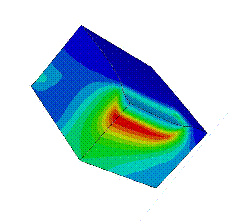
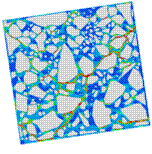
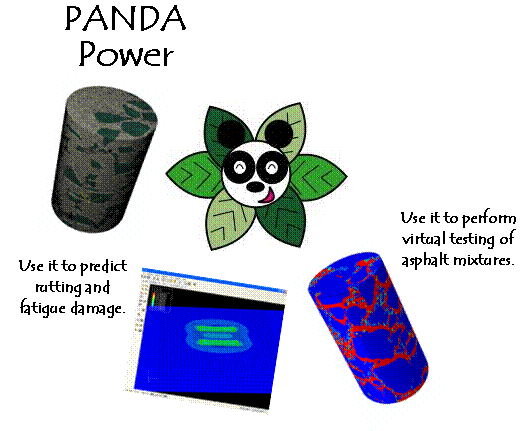
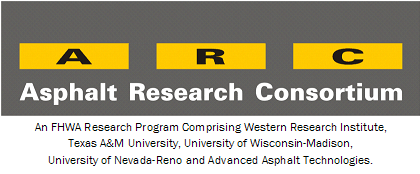
|
Texas A&M Subcontract Researchers at the University of Nebraska−Lincoln are advancing Cohesive Zone Modeling for fracture damage of asphalt mixtures and pavement structures.
|
|
When completed, the Cohesive Zone Model will be delivered in the form of a UEL (User ELement) code subroutine within the commercial finite element software, Abaqus. So in addition to serving as a stand-alone damage model, CZM will be integrated with PANDA to provide a powerful fracture engine. This enables modeling of nonlinear, viscoelastic, and viscoplastic responses on a scale from microfracture to complete failure of asphalt mixtures and pavements. |
|
CZM’s performance-predicting fracture model for asphaltic media and its associated test methods characterize the initiation and evolution of discrete cracks. |
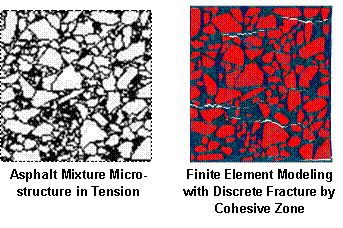
|
Model Simulations vs. Mixture Test Results |
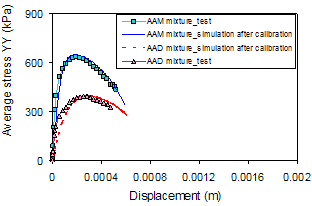

|
Cohesive Zone Modeling uses physically measured fracture properties in realistic length scales, providing a stand-alone complement to ARC modeling based on continuum damage approaches; these models typically characterize damage using phenomenological internal state variables. The Cohesive Zone Model (CZM) addresses inelastic fracture damage and failure of asphalt mixtures and pavements. In addition, the CZM can incorporate the influence of material inelasticity (viscoelastic and/or viscoplastic), nonlinear behavior, moisture-induced damage, and microdamage healing. |
|
The cohesive zone fracture model and relevant laboratory testing protocols have been developed with several different materials under various loading and environmental conditions. The model is being validated for simulating rate-dependent viscoelastic fracture of asphalt mixtures where realistic mixture microstructure characteristics and individual component properties are considered. |
|
The CZM is based on more accurate simulations and better understanding of fracture-related damage in asphalt mixtures and pavements. The model will give pavement and materials engineers a better approach to selecting mixture components for improved mixture microstructure and pavement structural design. ARC |
|
ARC work plan under review What’s Ahead? New products, new and continuing efforts
The Asphalt Research Consortium Year 5 Work Plan for April 1, 2011, to March 31, 2012, focuses on completing and delivering research from the first four years, as well as new starts on promising research of a more fundamental nature. Over the next six weeks, the work plan will be reviewed by Federal Highway Administration personnel and members of the FHWA Expert Task Groups (ETGs). The ETG members represent state and federal government transportation departments, industry, and academia. Their review is critical to ensuring that ARC research is in alignment with the user community’s needs and priorities. The participating ETGs are Fundamental Properties and Advanced Models (Models); Mixture and Construction (Mix); and Asphalt Binder (Binder). The Year-5 Work Plan includes 44 technology products that have been developed or advanced during the first four years of the ARC project. The 44 products range from those under initial development to those that are complete with methods formatted according to American Association of State Highway and Transportation Officials (AASHTO) standards and ready for their review. Adoption of new models, methods and other products by AASHTO on a provisional basis is the first step to becoming an AASHTO specification. As the Year 5 Work Plan progresses, products will be moved forward and new products will be added. The work plan can be viewed at www.arc.unr.edu on the ARC website, along with other information from the ARC. ARC
|
|
To remove your name from our mailing list, please click here. Questions or comments? E-mail us at psebaaly@unr.edu or call 775-784-6565.
Please Visit the ARC website to find references and links to Publications/Conference Proceedings, Presentations/Posters and other useful information. |